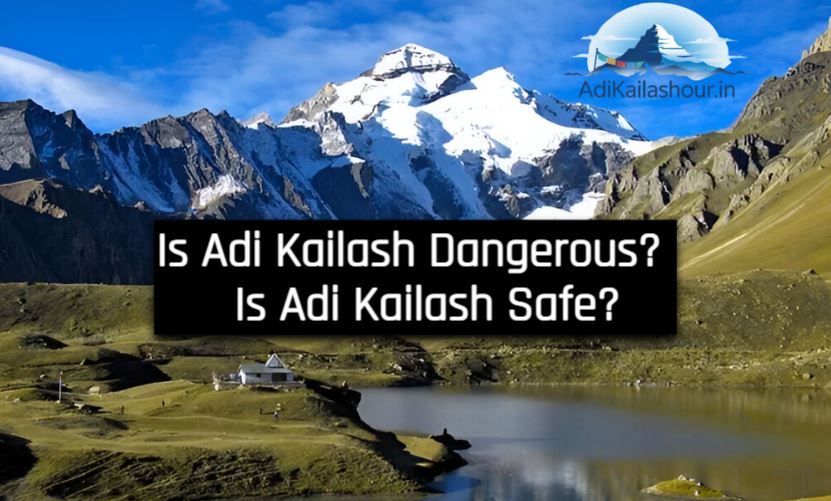Adi Kailash, located in the Kumaon region of Uttarakhand, India, is a sacred pilgrimage site revered by Hindus as an earthly residence of Lord Shiva. Also known as Chhota Kailash, this peak offers a spiritual alternative to Mount Kailash in Tibet. The question many potential pilgrims ask is whether Adi Kailash is dangerous or safe to visit. The answer depends on geographical conditions, preparation, and how one manages the challenges of the journey.
Geographical Conditions
Adi Kailash stands at an altitude of about 6,310 meters and is surrounded by the majestic Himalayan ranges, deep valleys, and fast-flowing rivers. The terrain can be harsh, involving steep climbs, narrow trails, and unpredictable weather. These factors can pose dangers to those who are unprepared. However, with proper guidance and awareness, the risks can be managed effectively.
Altitude Concerns
One of the major risks at Adi Kailash is altitude sickness. As the journey takes visitors above 12,000 feet, lack of oxygen, headaches, nausea, and fatigue are possible. Acclimatization becomes essential to minimize health risks during the trek.
Weather Conditions
The Himalayas are known for sudden weather shifts. Heavy rainfall, landslides, and snowfall can occur unexpectedly in this region. This makes the trekking routes temporarily dangerous, particularly during the monsoon season when landslides are frequent. Summer and early autumn are considered the safer seasons for travel.
Travel and Accessibility
Adi Kailash is accessible only through organized routes in Uttarakhand. The journey usually begins from Dharchula town, followed by a series of treks and off-road drives through villages like Gunji and Nabhi. While trekking involves physical challenges, the path is relatively safer compared to journeys in international terrains like Mount Kailash in Tibet, since travelers remain within Indian territory and have access to local support.
Government and Local Support
The Adi Kailash Yatra is coordinated by the Government of Uttarakhand and approved travel operators. Safety measures, medical assistance, and logistical arrangements are generally provided on such pilgrimages. Army and Indo-Tibetan Border Police (ITBP) presence in border regions also adds a layer of security for trekkers.
Potential Dangers
Although Adi Kailash is not as extreme as several other Himalayan expeditions, it does carry certain risks that pilgrims must prepare for:
Landslides and Roadblocks
Monsoon season often causes landslides that may block roads temporarily, making travel unpredictable. Hence, monsoon travel is discouraged.
Physical Strain
The trek requires stamina and physical preparedness. Those with respiratory or cardiac problems are advised to consult doctors before visiting, as the thin air can be dangerous for unfit travelers.
Remote Terrain
Being close to the Indo-Tibetan border, the region is remote with limited medical facilities. Immediate treatment during emergencies can be challenging, though makeshift camps and medical staff are usually available through official yatras.
Safety Factors
Despite its challenges, Adi Kailash is considered relatively safe for pilgrims, especially when compared to many other Himalayan expeditions. Several measures improve its safety:
Organized Pilgrimages
Traveling as part of an officially arranged Adi Kailash Yatra ensures that food, accommodations, and medical aid are provided during the trek, significantly reducing risks.
Border Security Presence
The region near the Indo-Tibetan border is guarded, which provides reassurance against security risks. Authorities also monitor pilgrim movement closely.
Community Support
Local villagers along the route often assist pilgrims with food, shelter, and guidance. This community support adds another layer of safety.
Best Practices for a Safe Journey
To ensure a safe pilgrimage to Adi Kailash, one must prepare adequately. Following certain guidelines can greatly reduce dangers:
- Choose the right season (May-June and September-October are the safest months).
- Train physically before the journey to build stamina for trekking.
- Acclimatize gradually to adapt to high altitudes.
- Carry prescribed medicines for altitude sickness and common health issues.
- Travel with official groups or government-approved operators only.
- Avoid solo travel in high-altitude stretches of the journey.
Comparison: Danger vs. Safety
Why It May Seem Dangerous
Because of its high altitude, unpredictable Himalayan weather, risk of landslides, and physical strain, Adi Kailash does present challenges that may be perceived as dangerous.
Why It Is Safe Overall
With organized tours, medical facilities, army presence, and improved roads, the risks are mitigated. Thousands of pilgrims successfully visit Adi Kailash every year without major incidents.
Conclusion
Adi Kailash is not free of danger, but it is not excessively hazardous either. With careful planning, physical preparation, and choosing the right travel arrangements, it is safe to undertake this holy journey. The mountain and its surrounding sacred sites like Parvati Kund and Om Parvat remain a great source of spiritual strength and tranquility for devotees. Thus, Adi Kailash can be described as a safe yet challenging pilgrimage, offering both divine blessings and a test of endurance.

